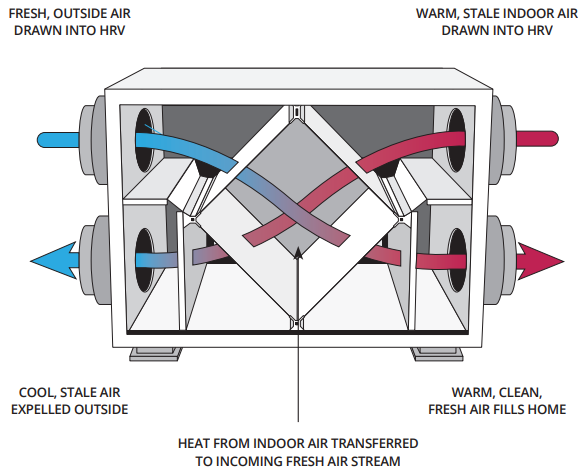Need help navigating retrofits?
Register for free today!
Heat Recovery Ventilator
Mechanical ventilation and filtration with a heat recovery ventilator (HRV) is an essential means of providing fresh air and maintaining healthy indoor air quality in a modern, well-sealed and insulated energy-efficient home. Once a home has achieved an air tightness of 3 air changes per hour (measured at 50 pascals), or lower, a heat recovery ventilator should be a requirement.
What are the Benefits?
Breathe easier
Stale air is replaced by a continuous supply of fresh air in your home. Air filtration also significantly reduces the particulate concentration in indoor air caused by climate change events such as forest fire smoke.
Superior health
Enhanced indoor air quality by exhausting indoor pollutants and introducing filtered fresh air.
Improved comfort
More even temperatures through improved air circulation.
Energy savings
Recovers heat normally lost through conventional ventilation systems, reducing energy costs and your carbon footprint.
How does it Work?
An HRV is a balanced ventilation system that uses a heat exchanger and a series of ducts and fans to blow stale air outside and bring filtered fresh air inside.
The HRV reduces heat loss by exchanging heat from outgoing stale air to warm up incoming fresh air. It also exhausts excess humidity to the outdoors.
What are the Costs?
The average cost for purchasing and installing an HRV vary. Factors that influence the cost include the size of your home, the model/brand and efficiency rating of the equipment and potentially the quality of the installation and system balancing. Be sure to get multiple quotes from contractors to compare costs, installation approach and warranties.
The Right System for Your Home
Getting optimal performance from a new HRV depends on more than just choosing the right equipment.
Consult with experts
Ask your builder, renovator, or energy advisor how this feature could transform your home.
Buy quality
Look for an HRV system with a high sensible recovery efficiency (SRE) rating to ensure a quality system.
Use an accredited installer
Contact a trained TECA (Thermal Environmental Comfort Association of BC) or HRAI (Heating, Refrigeration and Air Conditioning Institute of Canada) installer.
Ensure optimal performance
The quality of the installation can have an enormous effect on system performance and home comfort. Ask a builder, contractor or installer questions to ensure your system is properly sized and commissioned for optimal performance.
Maintain your equipment
Similar to servicing a vehicle, preventive maintenance is a good investment to minimize future problems. Arrange for annual servicing, keep the unit clean and inspect air filters every 1-3 months. Consult the owner’s manual for details.
Additional Resources
Combine provincial and federal programs for maximum rebates!

